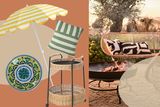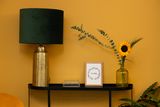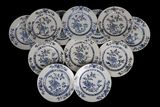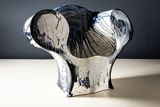Inside Orla Kiely's London home away from home
Designer's London Victorian abode with a 20th century twist
What makes a pattern iconic? My favourite example is Marimekko's Unikko pattern, now 50 years old and successfully reinvented, year after year.
The colour, background and scale may change but the simple poppy motif remains the same. People love it because it manages to be both familiar and new at the same time.
Orla Kiely's Stem pattern has a similar quality. Like Unikko, it is very simple - stylised leaves spread from a straight line - and it has the same capacity for reinvention. The secret, Kiely says, lies in the strength of the element and the simplicity of the repeat.
"Every season we come up with five new prints for our mainline fashion collection. Usually one or two has that longevity and versatility to cross over into homeware. I know instinctively which ones - It's an emotional response."
We're sitting in a coffee shop opposite her shop in London's Covent Garden as she tells me how the Stem became her logo.
"It was first designed around 2000, but it was just like any other print," she says. "We weren't thinking of it in terms of branding. We had done a stem against a white background on a cotton bag for summer. We were tiny in those days and we had to keep everything as simple as possible.
Kiely combines print with natural wood and clean-lined designs
Orla Kiely
Kiely's a fan of wood panelling
Orla Kiely's bedroom
Orla Kiely's kitchen
"I knew that we couldn't sell a cotton bag in the winter, so I put it down as a seasonal thing. Then I had a brainwave - to reprint the stem on a coloured background and laminate it. We took it to Paris and everyone went crazy! That was our first laminated bag and it was unique at the time."
It soon became clear that Kiely's patterns - with bold graphics, stylised motifs and orderly repeats - were versatile enough to cross over from fashion into interiors. Small items, like cushions and mugs came first and her full interiors range, Orla Kiely House, was launched in 2012.
Prices start around €10.95 for a small bowl or a tumbler, a pillow case will cost about €40 and double duvet cover €110. "I'm very fussy about quality and design," she says. "I really do make sure that it's of the highest standard - the challenge is to do it within a price that people can afford."
In many ways her homeware is an expression of a love affair with mid-20th century design, with a palette she describes as the "greens, greys and browns of the Irish landscape set against bursts of vibrant orange and yellow".
It all began in 198os Dublin, when Kiely, who hails from Shankill, Co Dublin, was studying fashion and textiles at NCAD. "I think that my interest in mid-century design came through textiles," she says.
"The designs that I loved when I was a student came from that time - they were bold, coloured, graphic, and clean. It was very unfashionable!"
The Stock Shop on Dublin's South King Street was a great source of inspiration. "That was the first time that I'd seen Marimekko fabric - I'd never heard of it. It was the boldest thing around."
Now Kiely runs her business from London, where she lives in a medium-sized Victorian house. A vintage 1960s pendant hangs from the plaster rose in the middle of the ceiling and the period fireplace is set against a background of her graphic wallpaper.
"I liked the period features and of course I wanted to keep them, but it was nice to bring that mid-century twist to it and mix things up a bit."
She has also added a sunken seating area, 1970s style, which allows for a sense of separation without the need for walls.
"I'm super happy with the kitchen," she says. "The walnut panelling is a lovely offset for the wallpaper. Back in the 60s and 70s they covered whole walls and ceilings with wood panelling. Wallpaper with a coloured background sits so happily beside it."
I ask her advice about using pattern in the home. "It is nice to combine patterns in a considered way but often less is more. You might not want colour and print on everything." She indicates a patterned ceramic storage jar with a big wooden lid (€33.95). "The lid kind of grounds it."
Kiely combines print with natural wood and clean-lined designs in a way that the Irish tend to see as Scandinavian. I point out that, back in the 1970s, similar comments were made about the Kilkenny Design Workshops.
"My DNA is Irish - whatever it is sparked what it is that I do has got to be Irish," she replies. "We do have a real Scandinavian following. The work has its own signature but they seem to like it."
Also like the Kilkenny Design Workshop, Kiely's success has attracted an element of begrudgery. Some critics, for example, felt that her limited edition butter packaging was a step too close to ubiquity. Others thought that her stylised flowers melded gracefully with the Kerrygold colours.
"If a project is interesting and has integrity, I'll do it," says Kiely. "I stick with things that I believe in and I say no to a lot of things."
Despite the clever branding, there's a core of tradition within her homeware range. I point out a woollen blanket (€180), neatly finished with old-fashioned blanket stitch, and say that I love the way that it's not a throw. Kiely laughs.
"The blanket is me again! I can't tell you how many times we've been asked to design a throw, but I love the idea of a proper blanket."
Visit www.orlakiely.com for Orla's latest homeware designs.
Join the Irish Independent WhatsApp channel
Stay up to date with all the latest news














